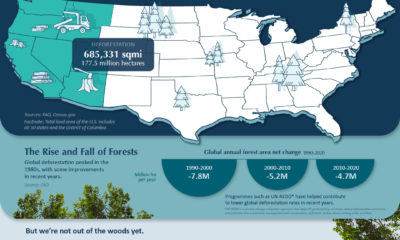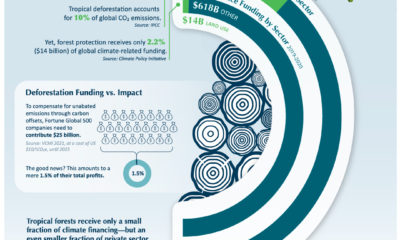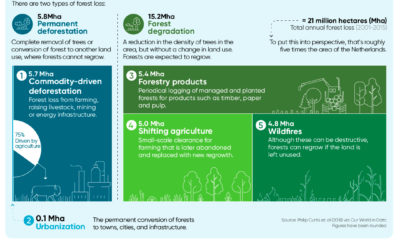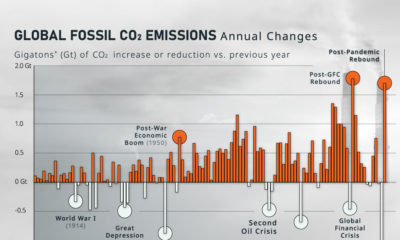But deforestation is threatening this natural infrastructure, releasing carbon into the atmosphere while simultaneously reducing wildlife diversity and making our environment more susceptible to environmental disasters. This graphic looks at global deforestation and forest growth over the past 30 years, mapping out the net forest change by country and region using data from the UN’s Food and Agriculture Organization (FAO).
The State of Deforestation by Region
Today, forests make up around 31% of the Earth’s total land area, spanning 15.68 million square miles (40.6 million km²). Over the past three decades, the world lost a bit more than 4% (685,300 square miles) of its forests, which equates to an area about half the size of India. Europe and Asia were the only two regions which had significant overall forest growth during this time period, while Oceania saw no significant change and North and Central America saw a slight reduction. Source: UN Food and Agriculture Organization Africa along with South America and the Caribbean were the regions with the greatest amount of net forest loss, both losing more than 13% of their forests over the past 30 years. This is largely because these two regions have large amounts of forest area available, with the underlying land in high demand for agriculture and cattle-raising. Although the overall forest loss around the world is massive, the rate of forest loss has slowed down over the past three decades. While an average of 30,116 square miles were lost each year between 1990 to 2000, between 2010 to 2020 that number has dropped to 18,146 square miles, showing that the rate of overall loss has fallen by almost 40%.
The Countries and Drivers of Deforestation and Forest Growth
Despite an overall slowing down of forest loss, certain countries in South America along with the entirety of Africa are still showing an increase in the rate of forest loss. It’s in these regions where most of the countries with the largest reduction in forest area are located: Source: UN Food and Agriculture Organization The other great driver of deforestation is seed and palm oil agriculture. These oils account for about 20% of the world’s deforestation carbon emissions, and their production concentrated in Indonesia and Malaysia is now expanding to other Asian countries along with Africa. While the demand for beef and palm oils drives deforestation, initiatives like the Central African Forest Initiative (CAFI) are providing incentives to protect forest land. Select countries in the European Union along with the United Kingdom and South Korea have committed $494.7 million to six central African nations (Cameroon, Gabon, Central African Republic, Democratic Republic of the Congo, Equatorial Guinea, and the Republic of Congo) for them to preserve their forests and pursue low emission pathways for sustainable development. The initiative has seen $202 million transferred thus far and an anticipated reduction of 75 million tons of CO2 emissions.
Forests and the Climate Crisis
It’s estimated that forests absorb around 30% of the world’s carbon emissions each year, making them the greatest and most important carbon sinks we have on land. When you pair this with the fact that deforestation contributes around 12% of annual greenhouse gas emissions, the importance of forest preservation becomes even more clear. But we often forget how much forests protect our environment by acting as natural buffers against extreme weather. Forests increase and ensure rainfall security, making nearby land areas significantly less susceptible to wildfires and natural droughts in hot and dry seasons along with flooding and landslides in wet seasons. With every dollar invested in landscape restoration yielding up to $30 in benefits, reducing deforestation and investing in reforestation is considered an effective way to reduce the difficulty and costs of meeting climate and environmental protection goals. This is without even considering the benefits of maintaining the world’s largest wildlife habitat and source of species diversity, the home of the nearly 70 million indigenous people who live in forests, and the livelihood of 1.6 billion people who rely on forests every day.
Preserving and Regrowing Forests for the Future
Despite the short-term acceleration in forest loss seen in 2020, there have been positive signs about forest regrowth coming to light. A recent study found that previously deforested land can recuperate its soil fertility in about a decade, and layered plants, trees, and species diversity can recover in around 25-60 years. Along with this, in some instances these regrowing “secondary forests” can absorb more carbon dioxide than “primary forests”, giving hope that a global reforestation effort can absorb more emissions than previously thought possible. From better financial incentives for local farmers and ranchers to preserve forest area to larger scale policies and initiatives like CAFI, curbing deforestation and promoting reforestation requires a global effort. Reversing forest loss in the coming decades is a daunting but necessary step towards stabilizing the climate and preserving the environment that billions of animals and people rely on. on Over recent decades, farmers have been able to more than double their production of crops thanks to fertilizers and the vital nutrients they contain. When crops are harvested, the essential nutrients are taken away with them to the dining table, resulting in the depletion of these nutrients in the soil. To replenish these nutrients, fertilizers are needed, and the cycle continues. The above infographic by Brazil Potash shows the role that each macronutrient plays in growing healthy, high-yielding crops.
Food for Growth
Nitrogen, phosphorus, and potassium (NPK) are three primary macronutrients that are the building blocks of the global fertilizer industry. Each plays a key role in plant nutrition and promoting crop growth with higher yields. Let’s take a look at how each macronutrient affects plant growth. If crops lack NPK macronutrients, they become vulnerable to various stresses caused by weather conditions, pests, and diseases. Therefore, it is crucial to maintain a balance of all three macronutrients for the production of healthy, high-yielding crops.
The Importance of Fertilizers
Humans identified the importance of using fertilizers, such as manure, to nourish crops dating back to nearly 6,000 to 2,400 BC. As agriculture became more intensive and large-scale, farmers began to experiment with different types of fertilizers. Today advanced chemical fertilizers are used across the globe to enhance global crop production. There are a myriad of factors that affect soil type, and so the farmable land must have a healthy balance of all three macronutrients to support high-yielding, healthy crops. Consequently, arable land around the world varies in the amount and type of fertilizer it needs. Fertilizers play an integral role in strengthening food security, and a supply of locally available fertilizer is needed in supporting global food systems in an ever-growing world. Brazil is one of the largest exporters of agricultural goods in the world. However, the country is vulnerable as it relies on importing more than 95% of its potash to support crop growth. Brazil Potash is developing a new potash project in Brazil to ensure a stable domestic source of this nutrient-rich fertilizer critical for global food security. Click here to learn more about fertilizer and food production in Brazil.































